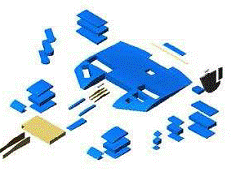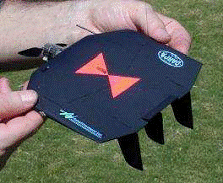





Published on Feb 14, 2025
Micro air vehicles are either fixed-wing aircraft , rotary-wing aircraft ( helicopter ), or flapping-wing (of which the ornithopter is a subset) designs; with each being used for different purposes. Fixed-wing craft require higher, forward flight speeds to stay airborne, and are therefore able to cover longer distances; however they are unable to effectively manoeuvre inside structures such as buildings.
Rotary-wing designs allow the craft to hover and move in any direction, at the cost of requiring closer proximity for launch and recovery. Flapping-wing-powered flight has yet to reach the same level of maturity as fixed-wing and rotary-wing designs. However, flapping-wing designs, if fully realized, would boast a manoeuvrability that is superior to both fixed- and rotary-wing designs due to the extremely high wing loadings achieved via unsteady aerodynamics .
The Black Widow is the current state-of-the-art MAV and is an important benchmark. It is the product of 4 years of research by Aerovironment and DARPA. The Black Widow has a 6-inch wingspan and weighs roughly 56 grams. The plane has a flight range of 1.8 kilometres, a flight endurance time of 30 minutes, and a max altitude of 769 feet. The plane carries a surveillance camera. In addition it utilizes computer controlled systems to ease control.


The Black Widow is made out of form; individual pieces were cut using a hot wire mechanism with a CNC machine allowing for greater accuracy.
The University of Florida has been very successful over the past five years in the MAV competitions. In 2001 they won in both the heavy lift and surveillance categories. Their plane was constructed of a resilient plastic attached to a carbon fibre web structure. This resulted in a crash resistant airfoil.
Newton's first law states a body at rest will remain at rest or a body in motion will continue in straight-line motion unless subjected to an external applied force . That means, if one sees a bend in the flow of air, or if air originally at rest is accelerated into motion, there is force acting on it. Newton's third law states that for every action there is an equal and opposite reaction . As an example, an object sitting on a table exerts a force on the table (its weight) and the table puts an equal and opposite force on the object to hold it up. In order to generate lift a wing must do something to the air. What the wing does to the air is the action while lift is the reaction.
Let's compare two figures used to show streams of air (streamlines) over a wing. The air comes straight at the wing, bends around it, and then leaves straight behind the wing. We have all seen similar pictures, even in flight manuals. But, the air leaves the wing exactly as it appeared ahead of the wing. There is no net action on the air so there can be no lift. Figure 3.7 shows the streamlines, as they should be drawn. The air passes over the wing and is bent down. The bending of the air is the action. The reaction is the lift on the wing.
As Newton’s laws suggests, the wing must change something of the air to get lift. Changes in the air’s momentum will result in forces on the wing. To generate lift a wing must divert air down; lots of air
Pilot reports and video recording through a small on-board camera indicate that our flexible wing micro air vehicles have unusually smooth flying characteristics. Most of our test flying is done using conventional RC equipment at close range, keeping the vehicle in continuous visual contact. Because of the small size of the vehicles, flying at distances greater than about 100 feet can quickly cause loss of orientation unless the pilot is flying by monitoring the video output from an on-board camera.
The RC transmitter produces a radio frequency signal that causes the RC receiver carried in the vehicle to develop a series of pulses of varying pulse widths (pulse width modulated or PWM) that are delivered to the control surface servos as the command signals for the desired positions of these surfaces. On the equipment we use, the pulses are generated at a constant frequency of 40 Hz. To capture this control input information, we have developed a simple system that uses a second RC receiver on the same RC frequency as the flight unit to monitor the pulse widths of the servo signals on the various servo terminals on the receiver and store the data on a notebook PC. With this system, stick input data is recorded without any contact or interference with the pilot or the micro air vehicle and the recording can be done at any reasonable range within the operating range of the RC system (at least 1100 meters).
a) It can be packed to 1/10 of original size.
b) It has Low mass.
c) It requires Low power requirements.
d) It has High reusability.
e) Outdoor NBC emergency reconnaissance
f) It has High stability and control.
g) It has High lift and slow landing speed.
h) Direct connectivity.
i) It can be individually controlled.
j) It can be used for a wide range of new missions.
a) The most important problem encountered so far is the quality of images taken from onboard TV equipment.
b) Micro air vehicles have small range of communication with controller.
c) It is very difficult to design flapping wing mechanism.
d) It is very difficult to control it in bad weather condition such as heavy rains etc.
e) It is very expensive to design micro air vehicles.
f) Lithium batteries which are generally used in MAVs are relatively expensive, particularly with reference to the common alkaline batteries with their widespread commercial use.
Micro Air Vehicles are a class of UAVs whose time has just about come. Micro Air Vehicles are the new development of the technology by which a variety of operations are done. An approach to design a flying mechanism different from the approaches being followed by the researchers around the world has been described. Simple flapping, which is an oscillatory motion of the wings about a fixed axis does not generate sufficient lift. Although biological have reported the efficiency of the Wies Fogh model the design using this model has not been attempted so far.
In the seminar, we highlight the recent research and development in establishing a flexible-wing-based technology for MAVs. Our effort addresses the entire scope comprehensively, including basic concept, novel fabrication approaches, aerodynamics investigations, and flight test data. The outcome is improved understanding of the key issues related to robust and stable flight and vehicle durability.
| Are you interested in this topic.Then mail to us immediately to get the full report.
email :- contactv2@gmail.com |